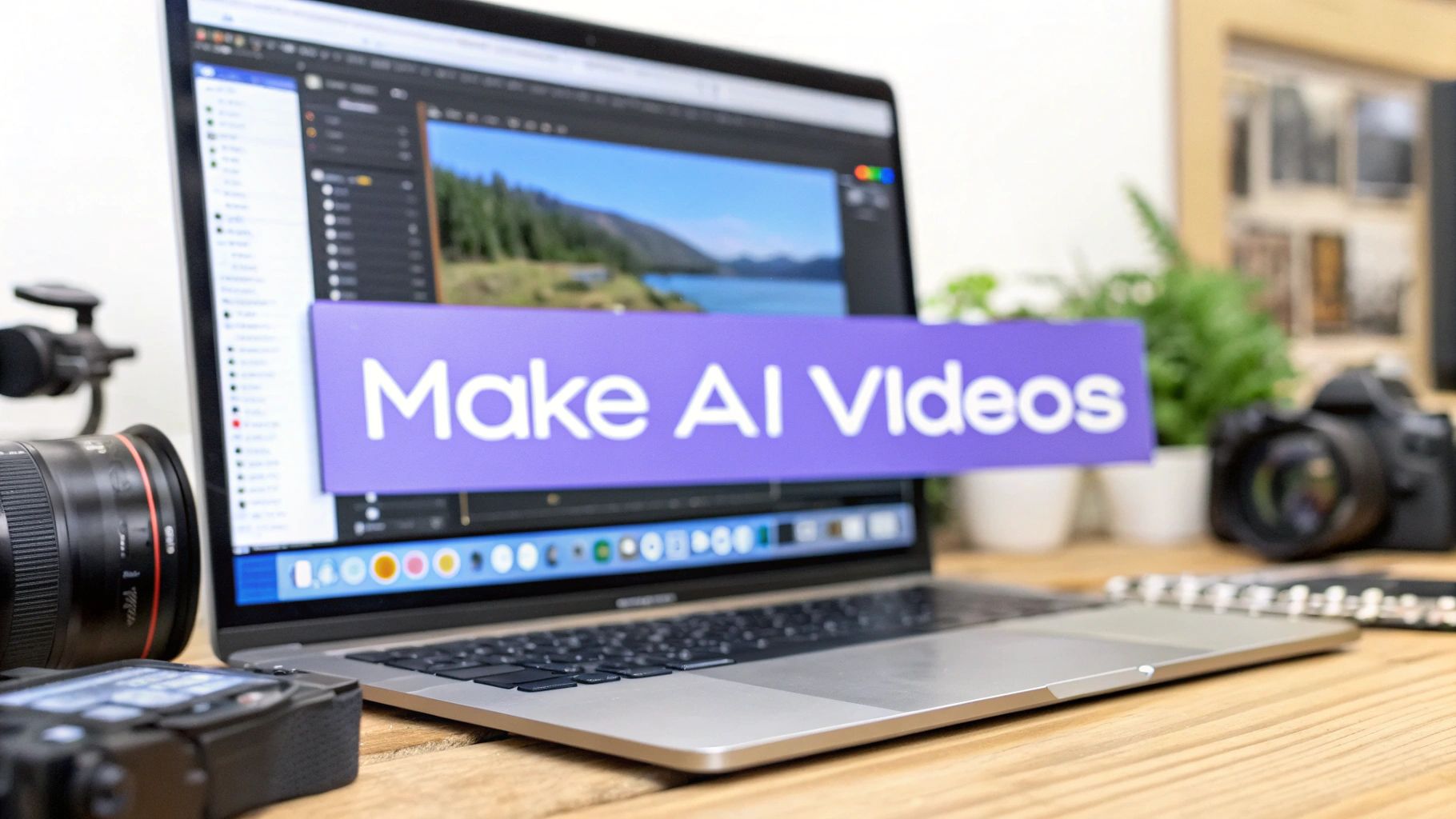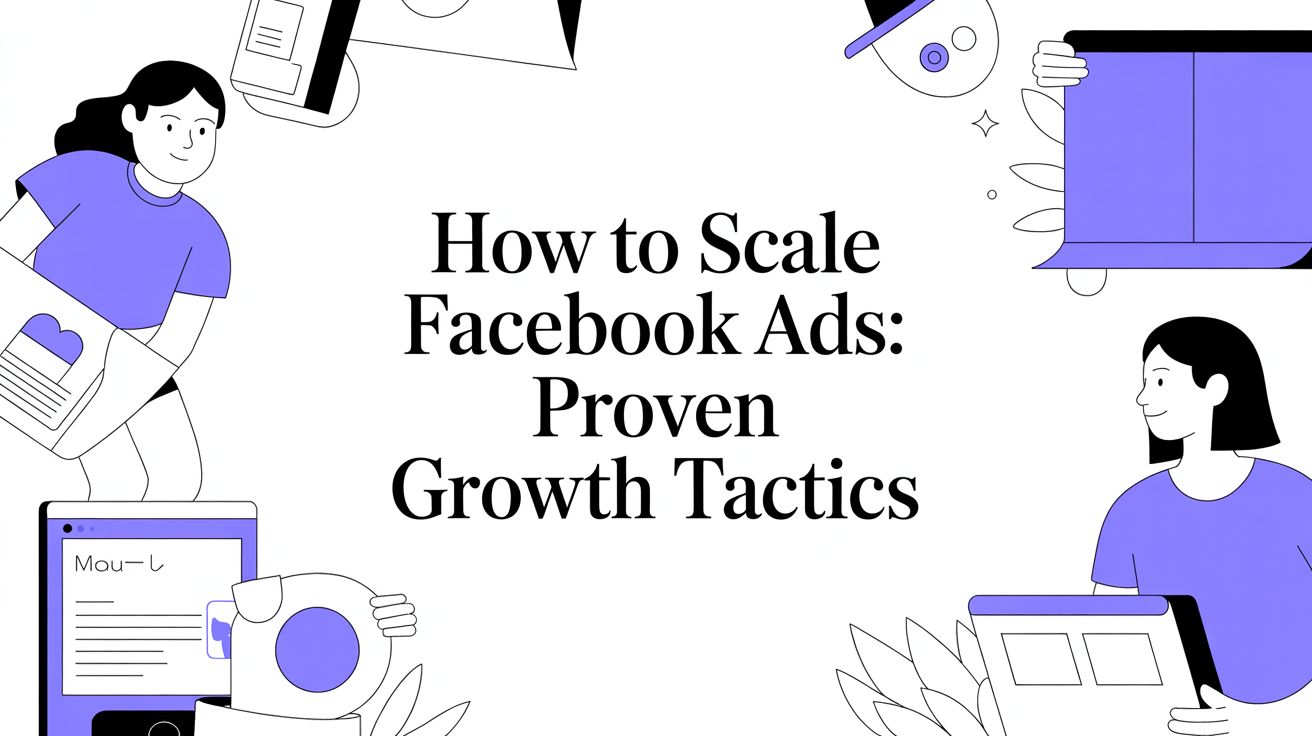Making a professional-looking video used to be a massive undertaking, often requiring a big budget and a whole studio. Not anymore. Learning how to make AI videos is a surprisingly straightforward process. It boils down to three main stages: planning your message, using a tool like Sprello to generate visuals from simple text prompts, and then piecing those clips together into a polished final video.
The goal is to turn your script into captivating visuals without ever touching a camera.
The New Era of AI Video Creation
Welcome to a completely new way of thinking about content. Creating amazing videos is no longer locked away for specialized agencies with deep pockets. It's now something marketers, small business owners, and solo creators can do right from their laptops. This shift is a game-changer, empowering anyone with a good idea to bring their story to life visually.
This guide is your roadmap. We’ll cover the entire process, from hashing out the initial idea and generating scenes to putting the final touches on your video before you share it with the world. Getting a handle on this workflow is the key to tapping into some seriously powerful technology.
Why This Matters Now
The move toward AI in video isn't just a cool trend; it’s a fundamental change in how content gets made. The ability to create at scale is mind-boggling. Instead of spending weeks or even months on a single video, you can now churn out multiple versions for different social media platforms in just a few hours.
This kind of speed and efficiency is completely rewriting content strategies. The global AI video generator market is expected to balloon to $1.5 billion by 2029. On top of that, a recent study revealed that 44% of marketers already consider AI a crucial part of their video marketing toolkit. If you're curious, you can dig into more AI video generator statistics to see just how fast this is all moving.
The real magic of AI video isn't just about being fast. It's about the creative freedom it gives you. You can experiment with wild concepts, test out different visual styles, and tell stories that would have been way too expensive to produce the old-fashioned way. It truly levels the playing field for high-quality video.
Let's break down the core stages you'll be working through. This table gives you a quick snapshot of the entire journey.
AI Video Creation At a Glance
A summary of the essential stages in the AI video creation process, from initial idea to final product.
| Stage | Key Action | Primary Goal |
|---|---|---|
| 1. Planning & Scripting | Define your message, audience, and key talking points. Write a clear script. | Establish a solid foundation and narrative for your video. |
| 2. Scene Generation | Use a tool like Sprello to turn lines from your script into visual clips. | Translate your written ideas into compelling, relevant video scenes. |
| 3. Editing & Polishing | Assemble the generated clips, add music, voiceover, and transitions. | Create a cohesive, engaging, and professional final product. |
| 4. Publishing | Export the final video and share it across your chosen platforms. | Get your message in front of your target audience. |
Seeing the process laid out like this makes it feel much more manageable, right? Each step builds on the last, taking you from a simple idea to a finished video.
Understanding the Bigger Picture
To really appreciate what's happening with AI video, it helps to see where it fits into the broader landscape of AI applications in digital marketing. Video is just one piece of a much larger puzzle. AI is already automating ad copy, personalizing customer experiences, and delivering incredible analytics.
By getting good at AI video, you’re not just learning to use a new app. You're building a skill that's becoming absolutely essential in modern marketing and communication. This is your launchpad for turning great ideas into visual content that actually connects with people.
Planning Your AI Video for Maximum Impact
Before you even think about writing a prompt, your video's success is pretty much decided by your plan. I’ve seen it time and time again: a solid blueprint is what separates a video that gets ignored from one that actually connects with people and gets results. This is where you nail down the what, who, and why of your project.
Rushing this part is a rookie mistake that almost always leads to painful re-dos later. Trust me, taking a few minutes now to map out your goals and get inside your audience's head will make the entire creation process with Sprello way smoother and more effective.
What’s the Point of This Video?
First things first, ask yourself a simple question: what do I want this video to actually do? Your answer is your guiding light. A video trying to sell a product is going to have a completely different vibe, script, and feel than one designed to just get your brand name out there on TikTok.
Your goal shapes everything that comes next. Be specific. "Get more engagement" is fuzzy. "Generate 50 new leads by getting viewers to our landing page" is a real, measurable goal you can build a video around.
Think about which bucket your video falls into:
- Teach Something: Are you breaking down a tricky concept or showing how your product solves a real problem?
- Entertain Someone: Is the goal to make people laugh, surprise them, or just build a good feeling around your brand?
- Get Them to Act: Are you trying to convince viewers to buy something, sign up for a list, or take another specific action?
Getting clear on this makes every other decision easier. This planning stage is the foundation for everything else, as you can see here.
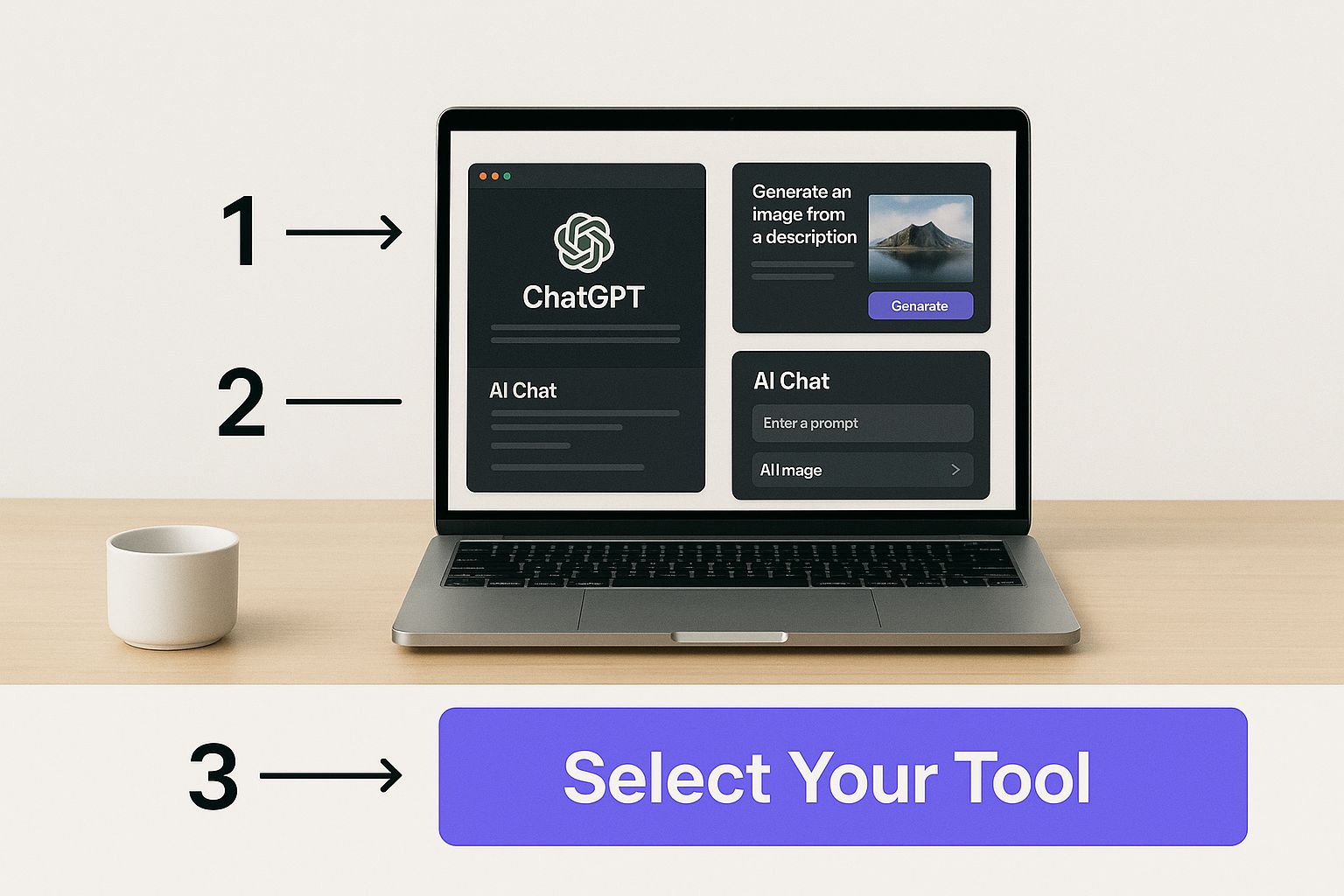
This just shows how thinking ahead and picking your tools wisely are the first real steps. It’s a simple but powerful way to make sure your creative energy is pointed in the right direction.
Writing a Script That Sounds Human
Once you know your goal, it's time to write. The trick to writing for an AI voiceover is to make it sound conversational. Seriously, write like you talk. Use simple words and short sentences. Long, complicated sentences are a dead giveaway of an AI voice and can sound clunky.
A great little test is to read your script out loud. If you stumble over words or it just feels weird to say, an AI voice is going to struggle even more. Chop up your script into different scenes or ideas. This makes it so much easier to match up your visuals later on.
My Two Cents: Your script is more than just words—it’s a set of directions for the AI. For every line you write, picture the visual that should go with it. Thinking about the audio and video together from the start is the key to making AI videos that look and feel professional.
For instance, a quick script for a marketing video might be structured like this:
| Voiceover Script | Visual Idea |
|---|---|
| (Upbeat, friendly tone) "Tired of your morning coffee going cold?" | A person looking sadly at a steaming mug on their desk. |
| "Meet the Everwarm Mug. It keeps your drink at the perfect temperature for hours." | A sleek, modern mug on a desk, maybe with a faint glow. A nice close-up shot. |
| "Never sip a lukewarm latte again. Click the link to get yours." | A hand happily grabbing the mug, then the website URL pops up on screen. |
This simple table gives both the AI voice and the image generator a clear roadmap to follow.
Writing Prompts That Actually Work
Your prompts are how you talk to the AI, so clarity is king. The more detailed you are, the better your visuals will be. A lazy prompt like "a person at a desk" is going to give you a boring, generic image every time.
Instead, you need to think like a film director. Pack your prompts with details. Talk about the lighting, the camera angle, the overall mood, and any specific objects you want in the scene.
A so-so prompt: A happy customer.
A much better prompt: A woman in her 30s with curly brown hair, smiling warmly at the camera, holding a modern coffee mug. She is sitting in a brightly lit, cozy home office. Close-up shot, soft focus background.
See the difference? The second prompt gives the AI specific marching orders, which hugely boosts your chances of getting the right shot on the first try. Playing around with different descriptive words and camera shots is all part of the fun. Don't hesitate to hit 'regenerate' a few times, tweaking your prompt until it’s just right.
Bringing Your Vision to Life with an AI Generator
Okay, you’ve got your plan and your script is polished. Now for the fun part: actually making the video. This is where your words and ideas get turned into a living, breathing piece of content. Using an AI video generator like Sprello feels less like wrestling with complicated software and more like directing a creative partner who can visualize anything you can imagine.
Let's walk through what this actually looks like in practice. We'll go from feeding your script into the generator to picking the perfect AI voice. The goal here is to pull back the curtain on the tech and show you how to stay in the driver's seat, making sure the final video is a perfect match for what you envisioned.
From Text to Visuals
The heart of AI video creation is the text-to-video engine. You take a line from your script, describe the visual you want in a prompt, and the AI generates a short clip to match. It's an incredibly powerful feature, but getting it right takes a little finesse. Don’t just copy and paste a sentence from your script into the prompt box. Think of each prompt as a direct command to your own personal cinematographer.
A lot of people wonder, Can Runway AI do text to video? The answer is a big yes, and it’s this exact capability that makes platforms like Sprello so potent. You're no longer held back by what you can film—your only limit is what you can describe.
For instance, instead of a bland prompt like "a person working," try adding some detail and flavor: "A young entrepreneur in a modern, sunlit office, typing energetically on a laptop, a focused but happy expression on her face, cinematic shot."
See the difference? That level of detail gives the AI much clearer instructions, which means you get a far more dynamic and professional-looking clip in return.
Mastering the Art of the Prompt
Your prompts are the single most important tool you have for getting great results. The better you get at writing them, the faster you'll be creating AI videos that really stand out. You have to think like a director setting up a scene.
Here are a few things I always try to include in my prompts for more control:
- Subject and Action: Be crystal clear about who or what is in the scene and what they’re doing. (e.g., "A golden retriever catches a frisbee in mid-air.")
- Setting and Environment: Paint a picture of the background. Is it a bustling city street at night or a serene beach at sunrise?
- Camera Angles and Shots: Tell the AI where to put the "camera." Are you looking for a
close-up shot, awide-angle view, or maybe adrone shotflying over a landscape? - Mood and Lighting: Use adjectives to set the tone. Words like
dramatic,uplifting,mysterious, orwarm and invitingcan completely change the feel of a scene.
Don't be afraid to regenerate. It's rare to get the perfect shot on the first try. I think of it as doing multiple takes on a film set. Tweak your prompt, change a few words, and generate it again. This back-and-forth is absolutely key to refining your vision.
The Sprello interface is built for this kind of rapid-fire creation, letting you generate and review clips without breaking your creative flow.
This dashboard view gives you a central hub to manage different projects and access all the AI tools. Having everything organized like this makes the entire workflow so much smoother, freeing you up to focus on the creative side of things instead of hunting for buttons.
Generating Clips in Batches
Here’s a pro tip that has saved me countless hours: generate your video in small, manageable chunks. Instead of trying to create the whole thing in one shot, just focus on one or two scenes at a time. Generate the clips for those scenes, review them, and make sure they flow together before moving on.
Working this way has a few huge benefits:
- Maintain Consistency: It’s way easier to keep the visual style and even a character's appearance consistent across a handful of clips than across a five-minute video.
- Catch Errors Early: If a certain prompt style isn't giving you what you want, you’ll know after two clips, not twenty.
- Stay Organized: It breaks a big, overwhelming project down into small, achievable tasks.
This kind of technology is completely reshaping how video gets made, making it faster and more accessible for everyone. AI's role is exploding; Gartner actually predicts that by 2025, a staggering 30% of marketing messages from major brands will be created by AI. This trend means even small teams can produce incredible content without needing a Hollywood-sized budget.
Selecting the Right Voice and Avatar
The visuals are only half the battle—your audio is just as critical. Most AI video platforms, Sprello included, come with a whole library of AI-generated voices. Take the time to listen to several options to find one that really fits your brand's personality, whether that’s energetic and friendly or authoritative and professional.
Many platforms are now rolling out AI avatars, which can add a really compelling human element to your videos. These digital presenters can deliver your script straight to the camera, forging a connection with the viewer that’s tough to get with a voiceover alone. If that sounds like something you'd want to try, you can dive deeper into creating realistic avatars for your videos in our dedicated guide. Nailing the voice and avatar is crucial for making your video feel polished, professional, and trustworthy.
Editing and Polishing Your AI-Generated Video
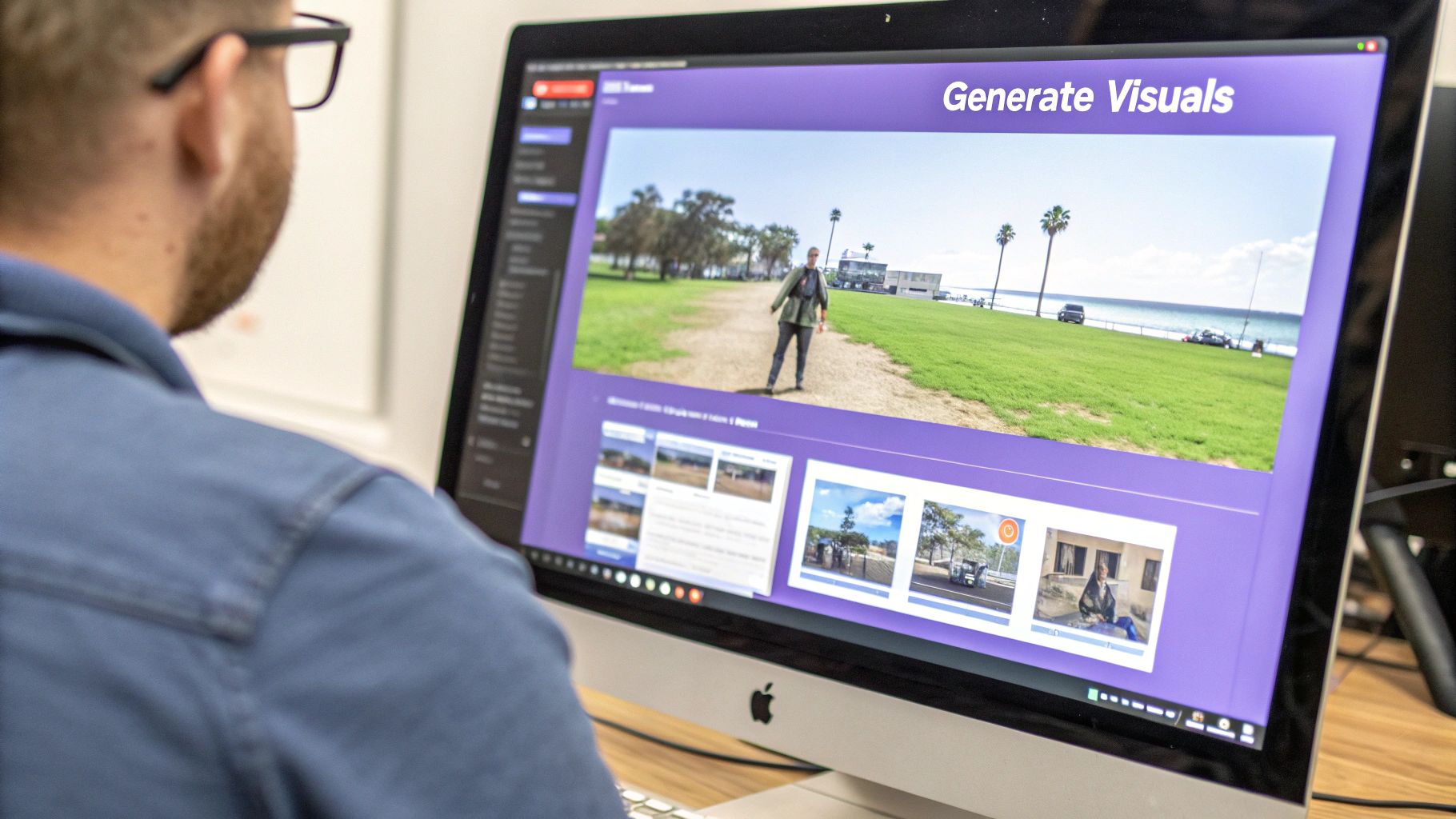
Alright, your AI has done its magic and you’ve got a folder full of video clips. Big step, but the real work starts now. This is where you step in to transform that collection of AI-made scenes into a story that actually connects with people.
A lot of newcomers learning how to make AI videos think that once the clips are generated, they're done. Honestly, the editing timeline is what separates a neat tech demo from a video that gets results. This is your chance to add that human touch, fix the pacing, and smooth out any of the little quirks that AI sometimes produces.
Assembling Your Story and Refining the Pace
First things first, let's build the narrative. Pull all those generated clips into your Sprello timeline or whatever video editor you're comfortable with. The goal is simple: arrange them in an order that follows your script and makes sense.
As you lay them out, watch it back. A lot. Does one scene feel like it’s dragging? Cut it down. Does a jump between two topics feel jarring? Maybe you need a simple cross-dissolve or a short B-roll clip to ease the transition. This part is all about feel—you’ll be trimming milliseconds and shuffling clips until the rhythm feels just right.
This is also your chance to be a detective. Keep an eye out for any AI weirdness, like a character who suddenly has six fingers or a background object that flickers out of existence. Catching these tiny flaws is what makes the final product look polished and professional.
The Power of Sound Design
Let's be real: audio is half the video. I'd argue it's even more important. You can have the most beautiful visuals in the world, but if the sound is bad, people will click away instantly.
Your sound design basically comes down to two things: the voiceover and the music.
First, check that your AI voiceover lines up perfectly with what's happening on screen. If it’s slightly out of sync, you might need to stretch a clip or add a tiny pause. Once that’s locked in, it's time for music. The right soundtrack can completely transform the video's mood.
- Launching a product? Go for something high-energy and exciting.
- Filming a tutorial? You'll want something subtle that sits in the background and doesn't distract.
- Telling a brand story? Find something with a bit of emotional weight to it.
After picking your track, you need to get the sound mixing right. This is critical. The music should never, ever compete with the person talking. It’s a common mistake that immediately screams "amateur."
My rule of thumb is to set the music volume so you can barely hear it when the voiceover is playing. It should support the narration, not compete with it. This single adjustment can dramatically improve the professionalism of your final video.
Adding Text Overlays and Calls to Action
Even with a great voiceover, a little on-screen text can help your key points stick. Use text overlays to highlight important stats, introduce a new section, or pop up a speaker’s name and title. Just keep it clean, readable, and consistent with your brand’s style.
And please, don't forget the Call to Action (CTA). Every video needs a purpose. What do you want the viewer to do when it's over? Make it impossible for them to miss.
I like to hit them with a one-two punch:
- Say it in the script: "To get started, click the link in the description below."
- Show it on the screen: A simple text overlay with your website or a "Subscribe" button.
This combo makes sure your message lands. The good news is that AI is making all of this so much faster. In entertainment, for example, AI tools have already cut editing time by an average of 35%. Some AI-powered rendering can even reduce production time by up to 45%—a lifesaver for anyone on a tight deadline. You can read more about these data-backed trends to see where things are headed.
The Final Review Checklist
Before you hit that export button, do one last quality check. After staring at the same project for hours, it’s incredibly easy to miss small mistakes. Step away for ten minutes, grab a coffee, then come back with fresh eyes.
Here’s a quick checklist I run through:
- Visual Flow: Any weird jumps or awkward cuts?
- Audio Quality: Is the voiceover crisp and the music mixed correctly?
- Text and Graphics: Any typos? (There’s always one!)
- Pacing: Does the video keep moving, or does it get boring anywhere?
- CTA Clarity: Is it 100% clear what the viewer should do next?
This final once-over is your last line of defense. Taking a few extra minutes here will ensure the video you publish is something you can be genuinely proud of.
Publishing and Promoting Your AI Video Content
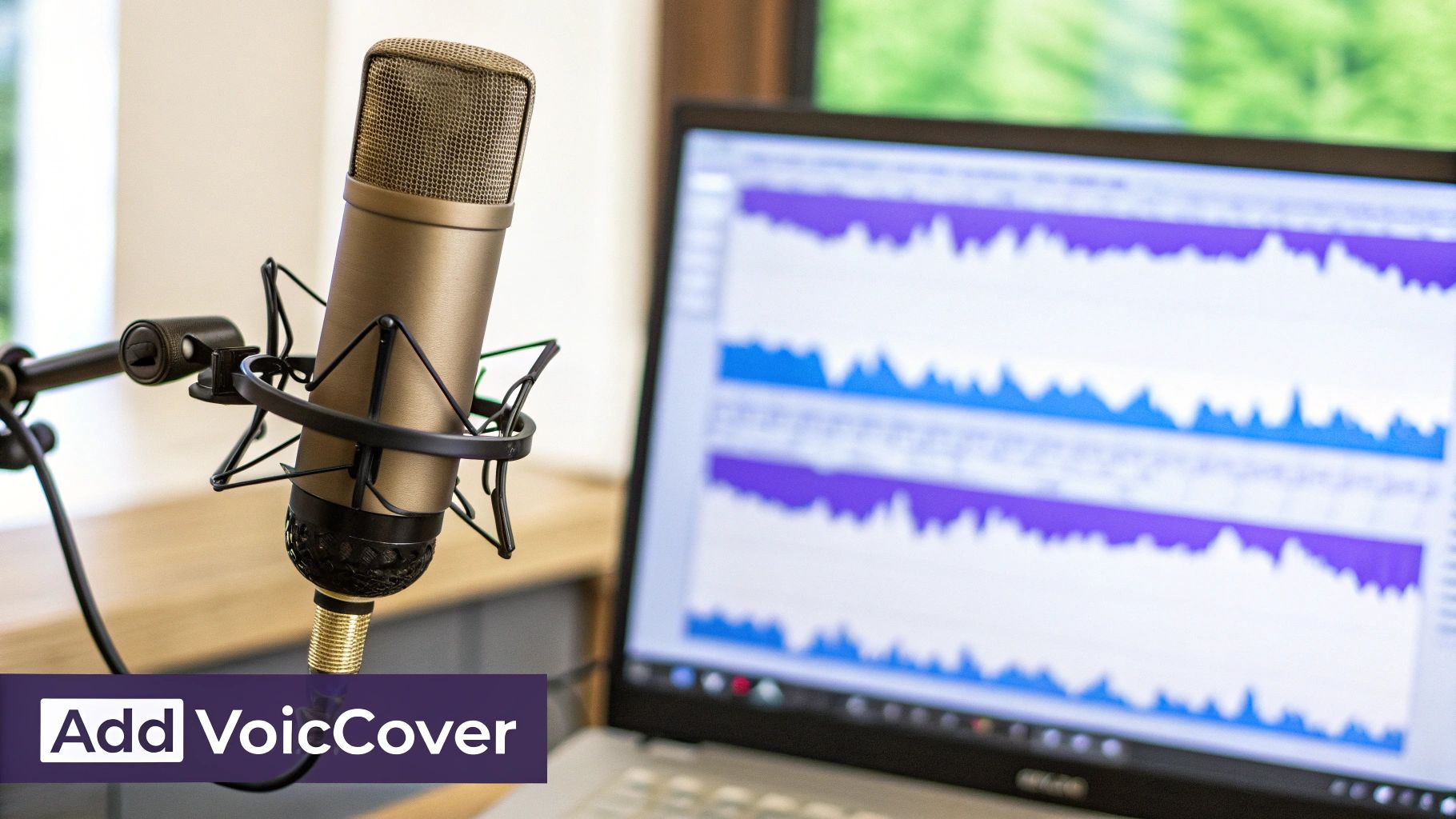
You’ve planned, created, and polished your video. That’s the hard part done, right? Almost. A brilliant video that no one sees is just a file taking up space on your computer.
The final, and most critical, part of getting results is getting your video in front of the right people. This is where your creative project becomes a real marketing asset. Let's walk through how to give your new AI video the launch it truly deserves.
Optimizing Your Video for Each Platform
Here's a common mistake I see all the time: creating one video file and blasting it everywhere. It just doesn't work. A video that looks amazing on YouTube can end up looking blurry and poorly framed on an Instagram Reel.
Before you even think about exporting from Sprello, you need to know where this video is going to live. Each social platform has its own preferences, and playing by their rules can make a huge difference in your reach. The algorithms always favor content that feels native.
Here’s a quick rundown for the big platforms:
- YouTube: This is still the king of high-definition, widescreen video. You’ll want to export in 1080p or 4K with a standard 16:9 aspect ratio.
- Instagram Reels & TikTok: It's all about vertical. A 9:16 aspect ratio is a must. Stick with 1080p resolution to keep it looking sharp on mobile screens.
- LinkedIn & Facebook: These are a bit more flexible, but vertical video still wins. A 4:5 or 9:16 aspect ratio takes up more of the screen on a phone, which is exactly what you want to stop the scroll.
Nailing the specs from the get-go makes your video look professional and gives it a better shot at performing well, no matter where your audience discovers it.
Crafting a Compelling Title and Description
With your perfectly formatted video file in hand, it's time to package it for discovery. Your title and description are your first—and often only—chance to grab someone’s attention.
A generic title like "Marketing Video Final" is a massive missed opportunity. You have to give people a reason to care. Think about the benefit or spark some curiosity. A title like, "How We Grew Our Email List by 50% With One Simple Video" is infinitely more clickable.
Your description should then build on that promise. Weave in relevant keywords people might search for, and—this is important—put your call-to-action link right near the top so it’s impossible to miss.
Pro Tip: Treat your title like a headline and your description like the opening sentence of an article. Your job is to give viewers a compelling reason to press play while giving search algorithms the clues they need to rank your content.
A Smart Plan for Promotion
Hitting "publish" is the starting line, not the finish line. Now you have to get out there and actively promote your work. A multi-channel strategy is the key to squeezing every bit of value out of a single video.
When it comes to getting your video out there efficiently, it's worth understanding what crossposting is and why it matters. It's a simple concept that saves you a ton of time and helps you get more mileage from the content you worked so hard to create.
Here's a simple but effective workflow you can use every time:
- Anchor it on a Primary Platform: First, upload the highest-quality version to its main home, whether that's YouTube or your company blog.
- Share Natively on Social: Next, create individual posts for LinkedIn, X (formerly Twitter), Facebook, and Instagram. Don't just paste the link—upload the video file directly to each platform. You'll get much better engagement.
- Embed it in a Blog Post: Give your video a permanent residence by embedding it into a relevant article. This adds huge value to your written content and is great for SEO.
- Send it to Your Email List: Your subscribers are your most loyal audience. They want to hear from you. Send out a dedicated email showcasing your new video.
This approach creates multiple ways for your audience to find your video. It also sends strong signals to search engines that your content is valuable because it's being shared and referenced in so many places.
And for those of you focused on generating leads, the next logical step is to learn how to create video ads with AI and turn this great organic content into a targeted, high-performance campaign.
Got Questions About Making AI Videos? We’ve Got Answers.
https://www.youtube.com/embed/ytQOk8P2zBE
Diving into AI video for the first time usually brings up the same handful of questions. It's a new frontier, after all, so it’s completely normal to have some "how does this actually work?" moments. Let's clear up some of the most common ones so you can get started with confidence.
Knowing what to expect is half the battle. It helps you set realistic goals for your projects and really make the most of these incredible tools.
How Long Does It Really Take to Make a Video?
This is usually the first thing people want to know. And the good news is, it's way faster than traditional video production, but it's not quite magic-wand instant.
For a simple, one-minute video where you have a solid script and a clear vision, you can genuinely go from idea to finished product in under an hour. No joke. But if you're aiming for something more ambitious—say, a five-minute piece with complex scenes and multiple revisions—you should probably set aside a few hours to get it just right. The AI does all the heavy lifting, saving you days of animation or filming.
Can I Use My Own Voice?
Absolutely, and you definitely should if you can. This is one of the best ways to keep your videos feeling personal and on-brand. Most top-tier platforms, including Sprello, have built-in voice cloning features.
It’s a surprisingly simple process:
- You just upload a clean audio sample of you speaking.
- The AI gets to work analyzing what makes your voice unique.
- Then, it generates the full voiceover for your script in a voice that sounds just like you.
Using your own cloned voice builds a much stronger connection with your audience. It's the perfect way to blend AI efficiency with your own authentic human touch.
What Are the Current Limitations I Should Know About?
As amazing as this technology is, it's not flawless. Knowing its current weak spots helps you work around them instead of fighting against them.
Right now, AI video generators sometimes get a little weird with things like realistic human hands or capturing very subtle facial emotions. You might also spot tiny inconsistencies from one scene to the next if your prompts aren't crystal clear. The trick is to lean into the AI's strengths—like creating breathtaking animated landscapes or slick product visuals—and use your editing skills to polish out any minor quirks. Checking out some of the 12 best AI tools for content creators can also show you which platforms are better at certain tasks.
Think of the AI as your creative co-pilot, not an autopilot. The best videos happen when you combine the AI's power with your own creative direction.
Can I Actually Monetize This Stuff on YouTube?
This is the million-dollar question for many creators. The short answer is yes, you can. YouTube allows monetization for AI-generated videos, but there's an important catch.
What YouTube really cares about is the value you provide, not how you made the video. Their policies are designed to filter out spammy, repetitive, or low-effort content. So, as long as your AI video is transformative—meaning you've added your own creative spark through a unique script, clever editing, a great story, and good sound design—it qualifies as original content. The effort you invest in making it special is what matters.
Ready to stop wondering and start creating? With Sprello, you can turn your ideas into high-performing videos in minutes. Sign up for your free trial and experience the future of content creation today at https://sprello.ai.
